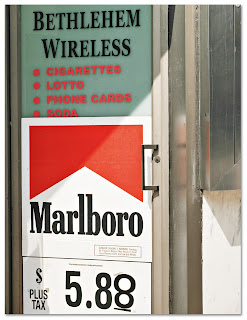Book Of The Week The Island Position Photographs by John Lehr Reviewed by Jake Bartman In The Island Position, John Lehr explores the facades of American commercial spaces that are threatened by the emergence of e-commerce. In a rush to remain relevant, storeowners emblazon their windows and walls with anything that will grab attention.
The Island Position
Photographs by John Lehr
Mack, London, England, 2019.
Unpaged, 8½x11½".
It is easy to take for granted the kinds of commercial environments that John Lehr aestheticizes in his new collection,
The Island Position. Here are the run-down facades of pawn shops and hair salons and payday loan-places, stores with windows blocked out by advertisements or cracked signage. One business is walled in by sun-bleached boxes; its neon signs advertise cell phones, electronics, and video games for sale. Another’s windows and doors are covered with handwritten signs that repeat the words “We Buy Cans ¢10 Plastic ¢30,” as if by force of enthusiasm to attract customers.
In the context of Lehr’s work these spaces are arresting, due in part to the urgency of the photographer’s project: an exploration of the existential threat brick-and-mortar businesses face from the rise of e-commerce. His achievement is to capture his subject in a way that’s neither naively sentimental nor unreflexively critical, at the same time as he eschews any claim to objectivity.
Devoid of people, Lehr’s images are lit with a flat, noon-like brightness that suggests the bleak future many traditional businesses face. There is wry humor at play throughout — as in the image of a fast food drive-thru, inverted via the mirrored window through which it’s viewed, or in another of two life-sized vinyl decals that depict the shelves of a well-stocked supermarket.
The book’s title is a term from print advertising — the “island position” is an ad slot surrounded by editorial content — and one of Lehr’s images is of a wall adorned with an oversized tropical beach scene, with several islands situated on the horizon. But these self-referential aspects are handled skillfully enough that the collection’s focus doesn’t stray into a meditation on the photographer’s role. Instead, Lehr maintains his focus on the human stakes of the shift to e-commerce.
That aim is bolstered by the inclusion of a short story from George Saunders, one of the country’s foremost authors of literary fiction. Saunders’ work often centers on characters who must fight to retain their humanity in the face of dystopian capitalism. His story “Exhortation,” from the 2013 collection
Tenth of December, takes a darkly absurdist approach to that theme. Written in the form of a corporate memorandum, the piece asks the employees of an unnamed company to better discharge unspecified duties in the mysterious Room 6. The story goes on to explore certain moral trade-offs inherent to modern labor.
Alongside Lehr’s images, the idea of Room 6 as a space in which certain activities are permissible receives added emphasis. The reader is left to consider the role of space in commerce, and to wonder: how does the presence of a physical environment in which to conduct business obscure, or remind us of, the ethical trade-offs that capitalism compels? How will we, as human beings, be changed by the absence of such places?
In e-commerce there aren’t handwritten signs, or faded advertisements, or even other people — at least, not that we can see. By effacing the presence of people from his images, Lehr’s collection compels us to forget the proprietors of such businesses. In that sense, we’re made complicit with the effects of e-commerce’s rise: we don’t perceive those who suffer from the shift, but only their absence. We’re left to wonder at what they, and we, have left behind.
Purchase Book
Jake Bartman is a writer and journalist living in Santa Fe. You can contact him at jbartman15@gmail.com.














